|

|
Ian S. Curthoys University of Sydney. NSW. Australia Topic:Probing vestibular function in Menière’s Disease with vHIT and VEMPs. |
Objective
One of the characteristics of Menière’s Disease (MD) is endolymphatic hydrops (EH) – the increased labyrinthine fluid volume causes changes in the delicate membranes of the inner ear and the question is can new vestibular tests be used to identify EH and so possibly function to identify people at risk of developing Menière’s Disease. This presentation concerns how vestibular evoked myogenic potentials (VEMPs) to sound or vibration and responses to head impulses are affected by EH. These are simple physiologically based clinical tests.
The physiological basis.
It is now clear that both linear accelerations and sound and vibration activate otolithic receptors in both the utricular and saccular maculae. There are two streams of afferent neural information from each macula – a sustained stream (afferents with regular resting activity, signalling gravity and low-frequency linear accelerations) and a transient stream (afferents with irregular resting activity originating from a specialized area of the macula (called the striola) signalling changes in linear acceleration and sound and vibration). Neurons in the transient otolithic stream are precisely activated by sound or vibration (e.g. 500Hz vibration) and using surface electrodes short latency myogenic potentials (VEMPs) are measured in patients from muscles activated by sound or vibration. Neurons in the sustained stream (regular afferents) are not activated by sounds or vibration at clinically acceptable levels. So VEMPs selectively probe the transient stream. Cervical vestibular evoked myogenic potentials (cVEMPs) are due to predominantly saccular activation and ocular VEMPs (oVEMPs) are due to predominantly utricular activation (Curthoys 2010). Otolithic receptors can respond to high frequencies if the otoconia remain fixed while the cell and hair bundle move resulting in deflections of the hair bundle.
Results
Menière’s Disease causes the best frequency for eliciting VEMPs to shift to higher frequencies (from 500Hz to 1000Hz). How? Modelling shows this shift will happen if the utricular macula becomes stiffer. The utricular macula rests on the flexible membrana limitans (ML) and so EH may cause increased stiffness of ML . Also histology shows that in MD patients the utricular macula is compressed and probably stiffer (e.g. Calzada et al 2012).
The eye velocity response in the video head impulse test (vHIT) to angular acceleration stimulation is apparently little affected in patients with MD. In contrast the caloric - shows clear decreased function in these same MD patients (McGarvie et al 2015). Radiography has confirmed the idea put forward by McGarvie et al that the increased endolymph volume in MD reduces the effect of temperature on the cupula in caloric testing but probably the response to head rotation is little affected. The dissociation between vHIT and caloric is being used as an indicator of Menières Disease
Conclusion
vHIT and VEMPs offer the opportunity to identify patients who may be progressing along the path towards Menière’s Disease before the patient has achieved the criteria for being diagnosed with definite Menières Disease.
